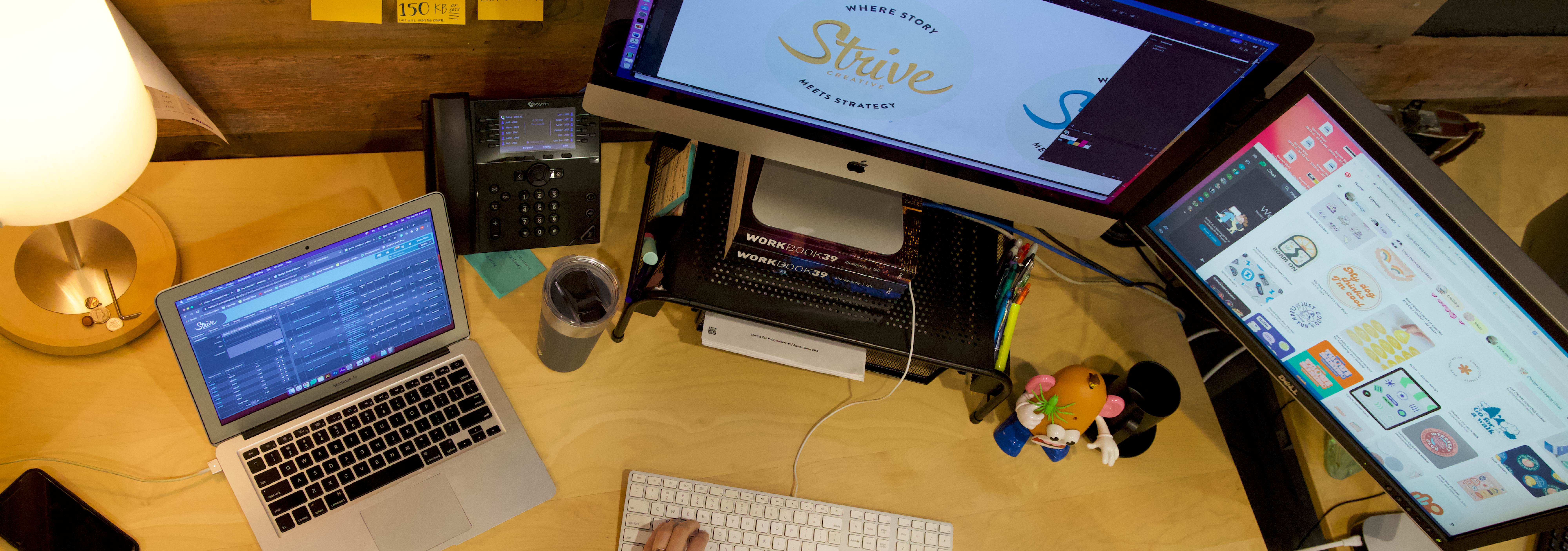DESIGN
Storytelling’s BFF
What catches your eye, and do you know why?
Design has a big job to do – it wants attention but for the right reasons. Ultimately its goal is to help enrich people’s lives, not just create more noise to filter through. We design for that “ah-ha” solution that seems simple and obvious but likely took great effort to achieve. “Clean and simple” isn’t a shortcut, but a slow down, explore, and refine type solve. If done well, you’ll never encounter that process, nor do you care. You just know the moment when you encounter something that resonates and you likely will tell others about it. That’s a self-replicating following – and it’s marketing gold.
Embracing Consumer Complexity
Customers, like all humans, are complex and their words don’t always match their actions. At Strive, we utilize behavioral science to decode this gap, gaining insights into their true preferences. This understanding allows us to anticipate and shape consumer decisions more effectively, navigating the fascinating landscape of human behavior.

Design isn’t art for art’s sake.
If it was, it wouldn’t depend on what people did or thought. It would just be its happy, beautiful self and that’s it. Our design transcends mere aesthetics; it’s a purposeful expression of larger concepts. We look closely at processes and barriers and create designs that clarify and enhance the message, avoiding confusion and inefficiency.

Be flexible and nimble, but precise.
While it is important to head confidently in a chosen direction, it’s equally important to maintain a certain level of fluidity. Embracing both confidence and adaptability, we navigate the design process with a balance of direction and flexibility. We make precise adjustments that significantly enhance our design outcomes that are responsive to feedback and market shifts.

Think of language and visuals like fraternal twins.
While these 2 facets of creative work are very different disciplines, they are inherently connected and supportive. Done right, they work together like a well-oiled machine. Done poorly or without focus, they can oppose each other and create a manner of discord. Regardless of which one drives the other, the goal is cohesion, support, harmony, and a bit of that ah-ha component.



Now you see me, now… what?
With design being a subjective experience, it can be one of the harder things to track in numbers and stats. Subjective measures such as awards and industry praise indicate that the work is creatively sound, but how is it really performing? To answer this, it is imperative to keep an eye on the work as it lives out in the world. We typically can’t pick our neighbors, and neither can an ad, commercial, or billboard. What we can do is pay close attention to how people react, both verbally and sometimes more importantly, non-verbally.
Lather, rinse, repeat.
Things like A/B testing give a good insight into how people respond to design decisions we make. Our design process is iterative, involving continuous testing and observation. This method allows us to refine our designs based on real interactions, ensuring they resonate with the target audience.

If you want to be taken seriously, be consistent.
Most likely you’ve experienced the difference between brands that delight in the details versus those that don’t. Consistency is key to a strong brand presence. We focus on creating cohesive branding across all platforms, recognizing that consistency in details fosters recognition and trust.

“Design is where science and art break even.”
Robin Mathew
At the heart of any design project, regardless of deliverables, there is a function – a task the item is expected to perform. If the design is beautiful and well-received that’s excellent, but is it doing what it’s supposed to do while being so nice to look at? We know design informed by science works. We therefore approach each project with a stronghold in application and functionality. Our goal is always to solve for what works and looks incredible while doing its job. A tall order, but one we have the experience to fill.
CONTACT US
We bring straightforward, actionable marketing strategies designed to deliver real results. Stay informed and ahead with insights and trends sent directly to your inbox.

